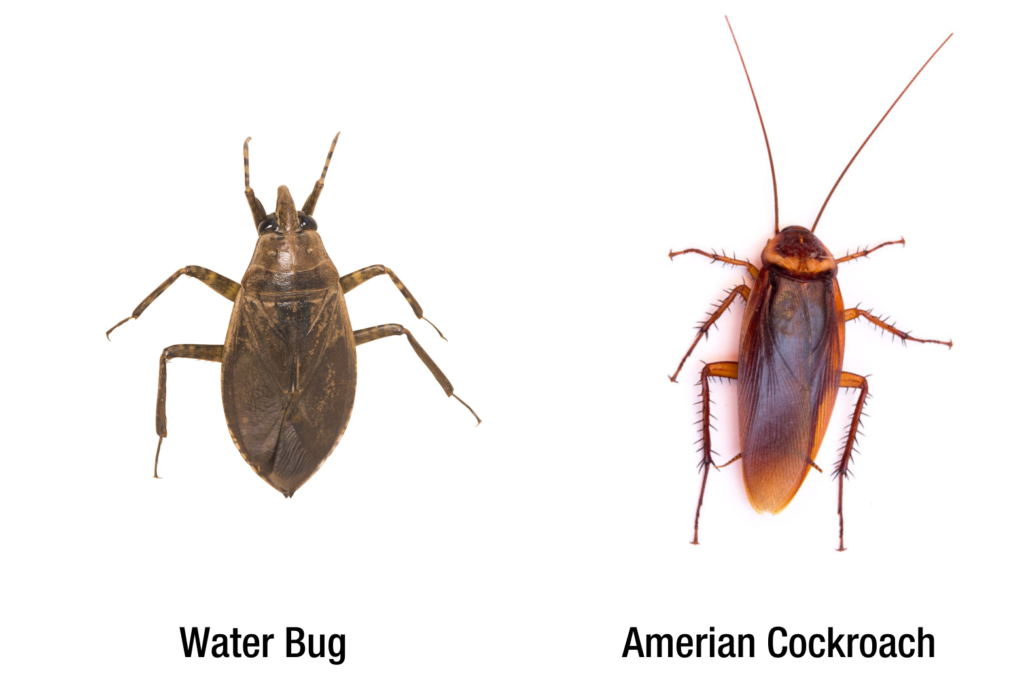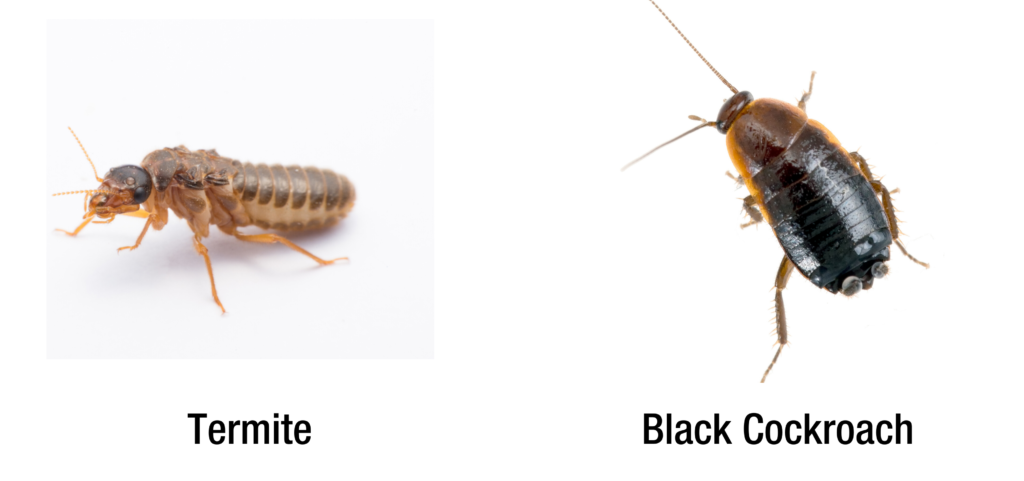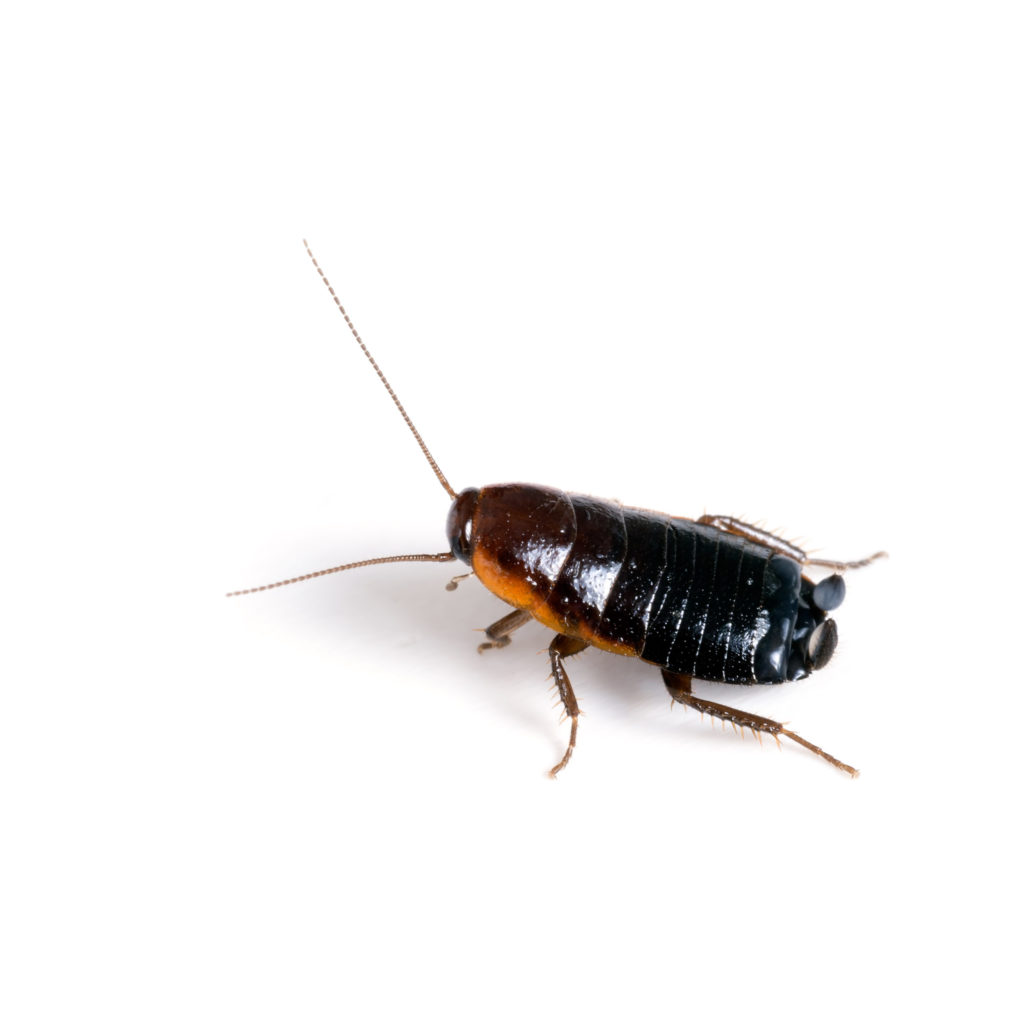You were at home relaxing when all of a sudden, something caught your attention.
It has six legs, an external shell, and what looks like wings.
You wonder: Is it a cockroach, or is it something else?
Then thoughts suddenly flood your mind. What could this mean? Should I be worried? Should I call an exterminator?
Don’t worry; we’ve all been there.
And in this article, we’ll demystify if you’re dealing with a cockroach or an impostor.
Let’s dive in.
1. Beetles
I’ll begin with the most common cockroach impostor, the Beetle.
There are over 400,000 species of beetles.
While not all beetles look like household cockroaches, some are similar to roaches in shape, size, and color.
Appearance

Some beetles appear eerily similar to roaches.
The June bug, for instance, looks an awful lot like German roaches.
Similar to German Roach, June bugs have a reddish-brown color.
Although they are rounder than cockroaches, they can be difficult to distinguish.
The Black ground beetle also looks quite like the Oriental cockroach.
Both insects have black, narrow bodies.
So how can you tell the difference between these two insects?
The easiest way is by looking at their legs.
Cockroaches tend to have longer legs and antennae than beetles.
Further, roaches’ wings are always visible, even at rest.
Beetles, on the other hand, fold their wings beneath their wing cases.
The Beetle also has a harder body than roaches, and they are often much smaller.
Their bodies are also much rounder compared to the flat, oval shapes of Cockroaches.
Behavior
If you can’t tell the difference based on the appearance, you can distinguish them based on behavior.
June bugs, like most bugs, are attracted to light, while German roaches avoid it.
Also, German Roaches will eat anything, while June bugs only eat plants.
The black ground beetle also acts differently than the Oriental roach.
Black Beetles like to float on water, while oriental roaches like just being around it.
Oriental cockroaches also tend to hang out with other roaches, while black beetles are lone wolves.
In general, beetles are slow compared to agile roaches.
Beetles also prefer to be outside, so you’re unlikely to see them in your home.
Bites
Beetles also bite humans, which rarely happens with roaches.
Roaches avoid humans as much as possible.
They will only bite humans in cases where there is no food available. This is the reason why most bites from roaches happen on ships.
Can they Fly?
For instance, June bugs can fly, while German roaches can’t. When German cockroaches use their wings, they flutter.
On the other hand, both the Black Ground Beetle and Oriental cockroach can both fly.
2. Palmetto Bug

What’s the difference between roaches and palmetto bugs?–Nothing.
“Palmetto Bug” is a fancy name used to refer to several species of cockroaches in the southern U.S, particularly in Florida.
Usually, when people say Palmetto bug, they refer to Florida Woods cockroach, American cockroach, and Smoky Brown cockroach.
The Florida woods cockroach earned this name because it enjoys hiding beneath palmetto leaves.
The American cockroach and Smokey Brown cockroach got it because polite southerners preferred not to admit to having a cockroach in their house.
Unfortunately, calling the term Palmetto bug leads to confusion.
Having a generic name for any medium to giant cockroaches causes many to misidentify the roaches.
For professor and entomologist Eric Benson, however, smoky brown roaches have the most legitimate claim to the name.
That is because smokey browns do sometimes hang out in the palmetto trees.
In contrast, American roaches tend to hang out in dark, damp areas like the sewer or storm drain.
Other nicknames for American cockroaches are flying waterbug, southern cockroach, and flying cockroach.
3. Water Bug
Many refer to various cockroach species as waterbugs.
But real water bugs live in water.
Examples of real water bugs are water boatmen and water scorpions. Both use their legs as paddles to move through the water.
Water striders and water spiders are also water bugs. These insects use surface tension to stay afloat.
What’s the difference between these two insects?
Appearance

Of all the roaches, the oriental cockroach is most commonly called a water bug.
That’s because oriental cockroaches and water bugs have similar physical traits–they are both shiny and dark in color.
But they do have obvious distinctions.
One of the most significant differences between a cockroach and a water bug is the antenna.
Cockroaches often have very long antennas, while waterbugs don’t.
Also, waterbugs have piercing mouthparts and a short, pointed beak under the sides of their heads.
Roaches are also much smaller.
Most waterbugs are relatively large and at least 3.8 cm long, compared to roaches who are only 1/2 inch large.
The only roach with size similar in size to a waterbug is the American roach.
But they are distinct in that a water bug has a yellowish figure-eight pattern on the back of the head.
Behavior
Cockroaches and waterbugs also defer in behavior.
While some cockroaches can survive in water, they prefer to be on land.
Water Bugs hunt their prey in the water. They subdue prey with their proboscis by liquifying their insides so they can suck it out.
In contrast, cockroaches will eat pretty much anything.
They are generally not hunters, but scavengers who eat garbage and crumbs.
Bites
Water bugs bite humans. While the bite is harmless, it can be excruciating.
In contrast, cockroaches rarely bite humans.
Biting only happens in places where there is a severe infestation, in which no human should be. It can also occur in ships if there’s not enough food for the roach (gross!)
Other than these instances, roaches are generally shy and will avoid humans as much as they can.
Do Water Bugs Spread Diseases?
Water bugs do not spread any diseases. so even if you come into contact with one there isn’t much to worry about.
4. Bed Bugs

Another type of insect that’s commonly mistaken for roach is bed bugs.
Here are their differences:
Appearance
While adult cockroaches will not look like bed bugs, baby roaches (nymphs) do.
Bed bugs have a reddish-brown color and a flat, oval shape. They are usually the size of poppy seeds throughout their life cycle.
Baby roaches appear white when they first hatch. But they will turn to reddish-brown later and will look eerily similar to bed bugs.
Compared to roaches, bed bugs are also more oval.
But the easiest way to distinguish between bed bugs and baby roaches are the length of antennas.
Roaches have long antennas. So if your see antennas that are as long as the insect’s body, you’re most likely looking at a cockroach.
Behavior
Like bed bugs, baby roaches like to hide in cracks and crevices closer.
But, unlike baby roaches, bed bugs usually live in the mattresses.
Baby roaches, on the other hand, shy away from humans.
They like being around damp, dark spaces where there’s food nearby.
Bites
Roaches typically shy away from humans.
In contrast, bed bugs are much more aggressive and bite humans frequently.
Bed bugs live by sucking blood.
Bed bugs like to attach themselves to humans and suck on their blood until they are full.
Their bite leaves an itchy red mark on the human skin.
But while roaches can bite, they very rarely do so.
Roaches are scavengers that live on trash, crumbs, and feces.
Roaches only bite if there is no other food available. As such, roach bites are the most typical on ships.
Can they Fly?
Some cockroaches fly, but Bed bugs do not.
Bed bugs travel from A to B by crawling, although they do have wings.
Bed bugs do not need to fly because they do not need to leave their home to survive. They stay on the mattress and feed there.
Most roaches can only flutter or glide, despite their wings.
But a few can fly.
That said, even the once that can fly will rarely do so. Most of the time, you’ll see they crawl to travel.
Do Bed Bugs Spread Diseases?
Unlike cockroaches, bed bugs do not spread disease.
Getting bitten by a bed bug will cause itching and will leave a red mark on your skin.
The worst side effect you can get from bed bugs are skin infections.
5. Termites
Roaches and termites are cousins.
DNA evidence shows that termites are related to a type of cockroach that tunnels into wood.
Studies suggest that termites had evolved from cockroaches about 150 million years ago.
Appearance

Adult cockroaches don”t look like termites, but baby roaches (nymphs) do.
A termite is roughly the same size as an ant (between ¼ and ½ inch long) and will stay that way for its lifetime.
In contrast, cockroaches can grow up to 3 inches in length.
There are around 40 species of termites in the U.S., ranging in color from white to light brown.
Baby roaches appear white when they first hatch.
But they will turn to reddish-brown later and can look similar to termites.
While cockroaches have long antennae, termites have short antennae.
Some termites carry the same body structure as a cockroach with a narrow abdomen and a large head.
Behavior
Both termites and roaches like to be indoors.
Termites build their colonies inside the small holes and crevices of wooden structures such as walls and furniture.
But, while roaches do hangout in tiny cracks, they also hang out under cabinets, furniture in attics, and basements.
Another difference between these two insects is how they socialize.
For the most part, cockroaches like to be alone.
But, termites live in colonies to similar ants. They have three castes: the reproductives, the soldiers, and the workers.
Diet
Termites feed on wood and paper.
They typically leave furniture and walls weak, by devouring wood from the inside out.
Cockroaches will sometimes eat wood, but far from exclusive. These critters eat anything from trash, crumbs, and feces.
Do They Bite?
Both termites and roaches can bite, but rarely.
Compared to roaches, however, termites bite more frequently.
Roaches only bite humans out of desperation. That is, they bite on occasions when there is no food available.
Termites, on the other hand, are aggressive insects. They will bite humans and other animals when they feel threatened.
Termite bites are not harmless and do not sting.
Do they Fly?
Both cockroaches, and termites can fly.
For cockroaches, only some species can fly while others can’t fly at all.
Termites on the other hand, can fly but this is mainly part of the reproductive process.
Male termies will fly away to start new colonies.
Once they have started the reproductive process they will shed their wings and begin working onthe colony.
6. Cricket
Another common insect that gets mistaken for a cockroach is the cricket.
Below are some of their key differences.
Appearance

Crickets have a very similar appearance as cockroaches with six legs, a hard exoskeleton and large wings over their abdomen.
Cockroaches have a rounder and flatter body while crickets are taller and more cylindrical.
Crickets are generally a light or dark brown, cockroaches can range from light brown to balck depending on the species.
German, American, and Smokey Brown can be mistaken for a cricket due to their size, and color.
One of main features separating the cricket and cockroaches is their large upright backlegs that they use for jumping.
Cockroach legs are smaller and flatter than crickets.
Behavior
Just like cockroaches crickets and cockroaches are both omnivores that survive on decaying matter.
Cockroaches are more generalist and have been found to eat anything to survive.
Crickets are typically found outdoors in grassy field and lawns.
While some species of cockroaches prefer the outdoors, many species of cockroaches prefer the indoors.
Crickets shy away from light and will use their long legs to jump away when threatened.
Cockroaches on the other hand will run or fly away when threatened.
Another key differences is that crickets often make their signature “chirp” by rubbing their wings together.
Cockroaches are silent and try to hide and stay in hidden as muuch as possible.
Bites
Both crickets and cockroeaches are capable of biting though it is highly unlikely.
Cockroaches are more likely to bite or nibble on humans when their is a lack of food sources.
While crickets are more likely to bite if they feel threatened.
Can They Fly?
Some species of crickets have wings and are capable of flying although they don’t use thier wings often.
Crickets are prolific jumpers and will often use their strong hindliegs to help them move around.
For cockroaches some species can fly while others have wins that are mainly nonfunctional.
Diseases
Crickets just like cockroaches are known for carrying diseases.
Crickets have the potential or carrying E.coli and salmonella similar to cockroaches.
Unlike cockroaches, crickets can also carry parasites and worms that are in their body.
They are released through the crickets feces and can attack to other items in your home.
Frequently Asked Questions
What Bugs Can Be Mistaken for Roaches?
Bugs commonly mistaken for roaches are termites, water bugs, June Bugs, Asian long-horned beetles, beetles, cricket, and bed bugs.
Do Cockroaches Have a Hard Shell?
No. Cockroaches have a papery shell.
Their exoskeleton may appear to be a hard shell, but they are soft.
It is there to protect their body and wings.
What do Cockroaches Look Like?
American Cockroach

- Appearance: The American cockroach is the largest of the household cockroaches. American cockroaches commonly grow up to 1 1/2 inches long. They are reddish-brown with a yellowish figure 8 pattern on their thorax.
- Region: They are located throughout the U.S.
- Habitat: You’ll find American cockroaches in damp and dark places like the sewers, pipes, and drains.
German Cockroach

- Appearance: German roaches grow up to 1/2 inch long. They have light brown, narrow bodies with two dark stripes located on their backs.
- Region: Found Throughout the US.
- Habitat: German love warm, humid places. You’ll typically find them in bathrooms and kitchens. A female German cockroach can have more than 30,000 babies per year.
Brownbanded Cockroach

- Appearance: Brownbanded cockroaches have brown, narrow bodies. They’re about 1/2 inches long and have yellow bands on their wings, abdomens, and thorax sides.
- Region: Found Throughout the U.S.
- Habitat: Compared to other roaches, Brown-banded cockroaches like to be in warmer, dryer, and higher locations. You’ll typically find them in upper cabinets, behind paintings, and other wall fixtures.
Oriental Cockroach

- Appearance: Oriental Cockroaches measure at about 1.25 inches in length. They have a shiny, dark color, ranging between reddish-brown and black.
- Region: Located in the northern part of the United States.
- Habitat: Oriental cockroaches love damp, dark places such as sewers and basements. But you can also find them in leaf piles and firewood outdoors. They exude a strong smell and are considered one of the dirtiest of all the cockroaches.
Smoky Brown Cockroach

- Appearance: Smoky brown cockroaches grow up to 1.5 inches long. They have a dark brown to mahogany-colored bodies with a black thorax. Their wings are longer than their bodies.
- Region: Commonly found in the Southeastern United States.
- Habitat: Smoky brown cockroaches are drawn to light. They enjoy warm, humidity, and wooded areas. They need to be near a reliable source of water as they are susceptible to dehydration. They are nocturnal creatures and will fly away if disturbed.
Asian Cockroach

- Appearance: Asian cockroach grows 1/2 inch long. They are light brown and have two parallel lines behind their thorax.
- Location: Commonly found in Southeast Asia and the Southeastern United States.
- Habitat: Asian cockroaches like in shaded, damp areas. They are an outdoor cockroach, but they also tend to wander in homes. These critters are attracted to light; they tend to crawl into houses at night.
